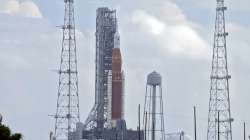Artemis I: NASA’s latest mission to the Moon is named after an ancient lunar goddess-turned feminist
Studies showed that female astronauts are less likely to be selected for space missions than men. 'Artemis' signifies the Greeks and Romans who associated Artemis with the Moon. She was a major Goddess who was worshipped in ancient Greece and has also become a modern-day feminist icon.

Artemis I is a well-developed and calculated mission that will be sending a rocket to orbit around the Moon for a month-long journey. The spacecraft will be carrying two mannequins instead of passengers. The aim of dummy mannequins is designed to study the effects of radiation on women's bodies so that NASA can comprehend better protection of its female astronauts.
In addition to this, recent studies showed us that currently, female astronauts are less likely to be selected for space missions than men because their bodies tend to hit NASA’s maximum acceptable threshold of radiation earlier. NASA is looking forward to bringing the first woman and person of colour to the Moon on Artemis III sometime after 2024. The programme aims to increase women’s participation in space exploration as 30% of its engineers are women.
As a scholar of Greek mythology, Marie-Claire Beaulieu: Associate Professor of Classical Studies at Tufts University, Boston finds the name of the mission appropriately reminiscent. The name 'Artemis' signifies the ancient history of the Greeks and Romans who associated Artemis with the Moon. At the beginning of the first millennium B.C., Artemis was a major Goddess who was worshipped in ancient Greece. She has also become a modern-day feminist icon.
Artemis was the daughter of Zeus, the chief god of the Olympians, who ruled the world from the summit of Mount Olympus. She was also the twin sister of Apollo, god of the Sun and oracles. She was a virgin goddess of the wilderness and hunting. Her independence and strength have long inspired women in a wide range of activities. For example, in a poem titled “Artemis,” author Allison Eir Jenks writes: “I’m no longer your god-mother … your chef, your bus-stop, your therapist, your junk-drawer,” emphasising women’s freedom and autonomy. As the goddess of animals and the wilderness, Artemis has also inspired environmental conservancy programs, in which the goddess is viewed as an example of a woman exercising her power by caring for the planet. However, while the Greek Artemis was strong and courageous, she wasn’t always kind and caring, even toward women. Her rashness was used to explain a woman’s sudden death, especially while giving birth. This aspect of the goddess has faded away with time. With the rise of feminism, Artemis has become an icon of feminine power and self-reliance.
NASA has a long history of naming its missions after mythological figures. Starting in the 1950s, many rockets and launch systems were named after Greek sky deities, like Atlas and Saturn, whose Greek name is Cronos. Atlas and Saturn weren’t just gods, they were Titans. In Greek mythology, Titans represent the untamed, primordial forces of nature, and so they evoke the prodigious vastness of space exploration. Although the Titans were known for their immense strength and power, they were also rebellious and dangerous and were eventually defeated by the Olympians, who represent civilisation in Greek mythology.
Following the advent of human space flight, NASA began naming missions after children of Zeus who are associated with the sky. The Mercury program, active from 1958 to 1963, was named after Hermes’ Roman counterpart, the messenger god who flies between Olympus, Earth and the underworld with his winged sandals. Starting in 1963, the three-year-long Gemini program featured a capsule designed for two astronauts and was named after the twin sons of Zeus – Castor and Pollux, known as the Dioscuri in Greek – who were cast in the stars as the constellation of Gemini. They were regularly represented with a star above their heads in Greek and Roman art.
The space shuttle programme, which lasted from 1981 to 2011, diverted from mythological monikers, and the names Columbia, Challenger, Discovery, Atlantis and Endeavour were meant to evoke a spirit of innovation. With Artemis, NASA is nodding back to the Apollo program, which lasted from 1963 to 1972 and put the first men on the Moon in 1969.
Over 50 years later, Artemis will pick up where her twin brother left off, ushering in a more diverse era of human space flight.
Also read: Artemis 1 mission: NASA calls off today's launch of new moon rocket after fuel leaks
Also read: NASA to re-attempt launch of new moon rocket on Saturday

